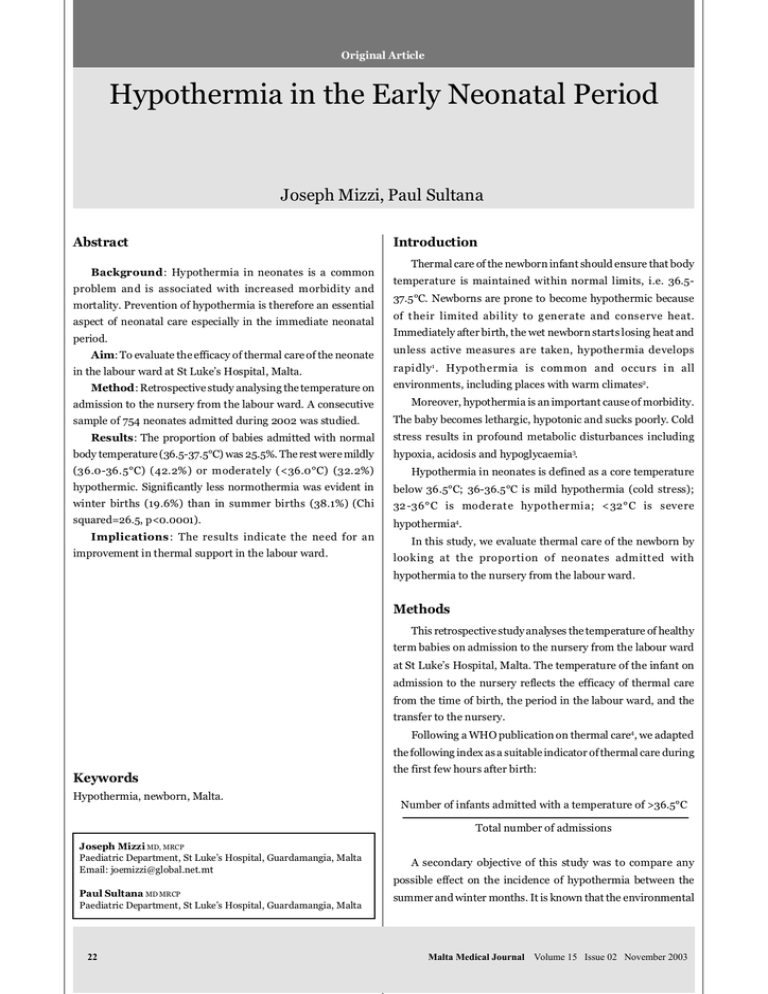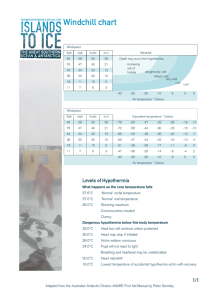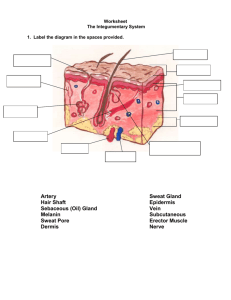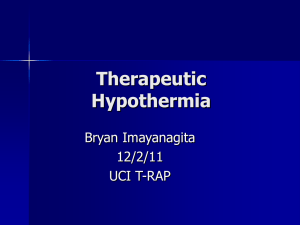Hypothermia in the Early Neonatal Period Joseph Mizzi, Paul Sultana Introduction Abstract
advertisement

Original Article Hypothermia in the Early Neonatal Period Joseph Mizzi, Paul Sultana Abstract Background: Hypothermia in neonates is a common problem and is associated with increased morbidity and mortality. Prevention of hypothermia is therefore an essential aspect of neonatal care especially in the immediate neonatal period. Aim: To evaluate the efficacy of thermal care of the neonate in the labour ward at St Luke’s Hospital, Malta. Method: Retrospective study analysing the temperature on admission to the nursery from the labour ward. A consecutive sample of 754 neonates admitted during 2002 was studied. Results: The proportion of babies admitted with normal body temperature (36.5-37.5°C) was 25.5%. The rest were mildly Introduction Thermal care of the newborn infant should ensure that body temperature is maintained within normal limits, i.e. 36.537.5°C. Newborns are prone to become hypothermic because of their limited ability to generate and conserve heat. Immediately after birth, the wet newborn starts losing heat and unless active measures are taken, hypothermia develops rapidly1 . Hypothermia is common and occurs in all environments, including places with warm climates2. Moreover, hypothermia is an important cause of morbidity. The baby becomes lethargic, hypotonic and sucks poorly. Cold stress results in profound metabolic disturbances including hypoxia, acidosis and hypoglycaemia3. (36.0-36.5°C) (42.2%) or moderately (<36.0°C) (32.2%) Hypothermia in neonates is defined as a core temperature hypothermic. Significantly less normothermia was evident in below 36.5°C; 36-36.5°C is mild hypothermia (cold stress); winter births (19.6%) than in summer births (38.1%) (Chi 32-36°C is moderate hypothermia; <32°C is severe squared=26.5, p<0.0001). hypothermia4. Implications: The results indicate the need for an improvement in thermal support in the labour ward. In this study, we evaluate thermal care of the newborn by looking at the proportion of neonates admitted with hypothermia to the nursery from the labour ward. Methods This retrospective study analyses the temperature of healthy term babies on admission to the nursery from the labour ward at St Luke’s Hospital, Malta. The temperature of the infant on admission to the nursery reflects the efficacy of thermal care from the time of birth, the period in the labour ward, and the transfer to the nursery. Following a WHO publication on thermal care4, we adapted the following index as a suitable indicator of thermal care during Keywords Hypothermia, newborn, Malta. the first few hours after birth: Number of infants admitted with a temperature of >36.5°C Total number of admissions Joseph Mizzi MD, MRCP Paediatric Department, St Luke’s Hospital, Guardamangia, Malta Email: joemizzi@global.net.mt A secondary objective of this study was to compare any possible effect on the incidence of hypothermia between the Paul Sultana MD MRCP Paediatric Department, St Luke’s Hospital, Guardamangia, Malta 22 summer and winter months. It is known that the environmental Malta Medical Journal Volume 15 Issue 02 November 2003 temperature has a significant effect on the risk to the newborn Figure 1: Proportion of normothermia on admission environment than adults do, and though the indoor temperature during the winter times may be perfectly comfortable for adults, it may be far too low for the neonate to maintain normal body temperature. On admission to nursery, the rectal temperature of all babies is taken routinely by the nursing staff and recorded in the ‘nursery notes.’ A clinical mercury-in-glass thermometer is used. Percent of Admissions of developing hypothermia. Newborns need a much warmer After discharge, the nursery notes are archived at the children outpatients department. The data for January, February, July and August 2002 was collected from the nursery notes. Chi-square analysis was performed to compare the number of normothermic infants admitted during the winter and summer months; Student’s t-test was used to compare the mean infant temperature on admission between the 2 groups. Discussion The very high incidence of hypothermia (74.5%) clearly indicates an inadequacy in the thermal care of neonates in the crucial hours after birth. Typically, a period of two hours elapses between delivery and admission to the nursery. Only a quarter Results of all infants admitted to the nursery had a normal body There were 754 nursery notes available, of which 53 did not temperature. have a record of the admission temperature. The numbers of A similar study in a UK hospital involving 69 infants showed infants with normal body temperature, and with mild and that 14% had a temperature of less than 36°C on the postnatal moderate hypothermia were tabulated (Table 1). ward5 . In our study, 32% had a temperature of less than 36°C 179 infants out of a total of 701 admissions had a on admission to the nursery. temperature of 36.5°C or more. Thus, 25.5% of new admissions Temperature measurements in the nursery are taken to nursery had a normal body temperature. 74.5% were rectally. This practice is considered hazardous, but it correlates hypothermic; 42.2% were mildly hypothermic; 32.2% were better with core temperature than the axillary site 6,7. The moderately hypothermic. American Academy of Pediatrics recommends the axillary site The mean temperature recorded in neonates in the winter for temperature measurement, mainly because of the risk of period was significantly lower (0.3 degrees centigrade) than the rectal perforation 8,9. The use of mercury-in-glass thermometers mean temperature in summer (p<0.0001). The number of has been banned in most centres and the electronic infants admitted with a normal body temperature during thermometer, which is accurate, safe and measures the January and February was 93 out of 475 (19.6%); and during temperature quickly, should substitute it. The SI unit for July and August, 86 out of 226 (38.1%). Significantly less temperature, the Celsius, should be adopted as in most normothermia was evident in winter births than in summer European countries. If the temperature is <36.5°C, active births (Chi squared=26.5, p<0.0001) (Figure 1). measurements should be taken to re-warm the baby. Comparison between the proportion of admissions of The problem of hypothermia is worse in January and neonates to the nursery with hypothermia and normothermia February and this suggests that the indoor temperature is lower during winter (January/February) and summer (July/August), during winter. The delivery rooms are warmed by radiant 2002. Table 1. The number of infants classified under various temperature groups. Jan/Feb Jul/Aug Totals Moderate hypothermia <36°C Mild hypothermia <36.5-36°C Hypothermia (total) <36.5°C Normal body temperature >36.5°C Total number of infants 181 (38.1%) 45 (19.9%) 226 (32.2%) 201 (42.3%) 95 (42.0%) 296 (42.2%) 382 (80.4%) 140 (61.9%) 522 (74.5%) 93 (19.6%) 86 (38.1%) 179 (25.5%) 475 226 701 Malta Medical Journal Volume 15 Issue 02 November 2003 23 Table 2: Guidelines for thermal care in the labour ward, adapted from a WHO publication4. Given the high incidence of hypothermia in the first hours after birth, it is recommended that, following discussions with the midwifery staff, there is an immediate implementation of 1. The temperature of the delivery room should be at least 25°C and there should be no draughts. 2. Immediately dry the newborn after birth with a warm towel, and remove wet blankets. 3. Place a cap on the baby’s head. 4. Place in skin-to-skin contact with mother and cover with a warm blanket; or bundle in warm blankets, and give the baby to mother to hold; or dress in warm clothes, and place in a pre-warmed closed incubator (temperature 33°C). 5. Initiate breast-feeding within one hour of birth. 6. Bathing and weighing should be postponed. The baby should be bathed at least 6 hours after birth, and preferably on the second day of life, and only if the baby is healthy and has normal body temperature. 7. During transportation, use skin-to-skin contact with mother; or dress and wrap the baby in blankets. the WHO recommendations for thermal protection in the labour ward (Table 2). A future audit is indicated to reassess thermal care in the labour ward after the implementation of these measures. Acknowledgements We thank Dr Victor Grech for his assistance in the statistical analysis of the results. heaters but there are no wall thermometers to measure the ambient temperature. No temperature records of the delivery rooms are available. The operating theater is centrally heated and the temperature is kept at 24°C during Caesarian Sections. When using spinal anaesthesia, the temperature is maintained at higher value (28°C) because the newborn remains with the mother. The average temperature in the Maltese islands during January and February is 12°C (the mean high is 16°C and the mean low is 9°C). During July and August, the average temperature is 26°C (the mean high is 31°C and the mean low is 21°C) 10. The difference is ambient temperature is reflected in the increased incidence of hypothermia (80.4%) in winter compared with 61.9% in summer. This implies the need for more active warming of the delivery rooms during winter. Yet, the warm summer months should not be taken with a laisser-faire attitude since hypothermia is still very common during this period. Certain factors in the current practice in the labour ward may contribute to the occurrence of hypothermia. The delivery rooms may not be warmed sufficiently since there are no wall thermometers to measure and control the ambient temperature. Many babies are washed soon after birth and a cap is rarely used. 24 References 1 Dahm LS, James LS. Newborn temperature and calculated heat loss in the delivery room. Pediatrics, 1972; 49:504-513. 2 Tafari N. Hypothermia in the tropics: epidemiologic aspects. In: Sterky G, Tafari N, Tunell R. (eds). Breathing and warmth at birth. Sarec Report: 53-58, 1985. 3 Gomella TL. Temperature Regulation. In: Neonatology. 4th ed. New York: Appleton & Lange; 1999. p. 38-42. 4 Thermal protection of the newborn, a practical guide, WHO/ RHT/MSM/97.2 [online] 1997 [cited 2002 Sept 15]. Available from: URL: www.who.int/reproductive-health/publications/ MSM_97_2_Thermal_protection_of_the_newborn/ MSM_97_2_table_of_contents_en.html. 5 Hutton-Taylor RS. Incidence of and contributing factors to hypothermia in the newborn at term. Midwifery Research Database [serial online] 1993 [cited 2002 Sep 13] Available from: URL: http://129.11.5.57/miru/miriad/s0455.htm. 6 Brown PJ, Christmas BF, Ford RP. Taking an infant’s temperature: Axillary or rectal thermometer? N Z Med J 1992;105:309-11. 7 Morley CJ, Hewson PH, Thornton AJ. Axillary and rectal temperature measurements in infants. Arch Dis Child 1992; 67: 122-25. 8 Kresch MJ. Axillary temperature as a screening test for fever in children. J Paediatr 1994;104:596-9. 9 Frank JD, Brown S. Thermometers and rectal perforation in the neonate. Arch Dis Child 1978; 53(10): 824-25. 10 Monthly Averages for Valletta, Malta. The Weather Channel [online] [cited 2003 April 21]. Available from: URL: www.weather.com/outlook/travel/climatology/monthly/ MTXX0001htt. Malta Medical Journal Volume 15 Issue 02 November 2003



